#Learn Gita Live Gita
Explore tagged Tumblr posts
Text
“What I've learned from women who are totally killing it”
Part 2
(part 1)



☁️ The secret to be the luckiest person in the room is to always think in your favour, no matter the circumstance is.
☁️ A daily routine actually makes your day easier. But the key is to have one which resonates with you.
☁️ Stop blindly following routines you see on the internet; they don't even resonate with you. Ex: Maybe you're not a gym person, but you're half heartedly going to the gym just bc of xyz routine. Instead, try to find what you actually like, such as yoga or exercises.
☁️ Never apologize for things which gives you joy and is literally hurting nobody. Trust me honey you don't wanna be 70 and live your life regretting things you could have loved and enjoyed but didn't. So go stream your ‘not so cool’ artist and enjoy that ‘boring’ hobby.
☁️ The happiness you're searching outside is within you. You will never ‘arrive’ to happiness, it's in the small things you do.
☁️ Music or the songs you listen to can actually affect how you feel all day ! When I started listening to songs with affirmations, I found myself humming those songs again and again. Similarly, when I listened to sad songs I found the same thing. Your subconscious believes what it's hearing, so be mindful of the music you listen to.
☁️ Honey, you're punishing your body if you're only using water and soap/body wash while bathing. Your body deserves to be properly cleaned and these aren't enough to remove the dead skin cells. All you need to do is use an exfoliating tool such as a washcloth, body sponge, loofah, etc. If you don't have access to these right now, then even a simple cotton napkin will work.
☁️ If you're religious and want to have stronger connection with God then the best way you can do it is by reading your religious scriptures. Whether it's the Gita, Bible or Quran, it will provide you with more knowledge than anyone else can.
☁️ “The fears we don't face become our limits” I spent a whole minute reading this quote again and again. One of the most moving quotes I've came across for sure. (I can make a whole post with all my fav quotes too!)
☁️ ‘Nature is women's best friend.’ Take some time out of your day to spend time in nature. Feeling anxious? Take a walk in the garden. Feeling like the world is cruel and everyone is against you? Go hug a tree. Trust me sweetheart, nature has the solutions to all your problems.

#wellness#health and wellness#mindfulness#it girl#that girl#dream girl#pink pilates princess#pink blog#aesthetic#quotes#positive affirmations#wonyoung#wonyongism#hyper feminine#clean girl#girl blogger#girlblogging#self love#self improvement#self care#mental wellness#affirmations#manifesation#couqette#girly#productivity#positive thoughts#just girly things#advice#thewizardliz
304 notes
·
View notes
Text
In a key scene in Red Dragon, an FBI agent tells a group of police officers that there is no doubt that the family serial killer will strike again. “Why?” one woman asks him. “Because it makes him God,” intones the agent. Just days after Red Dragon opened, the police found the Death card from a Tarot deck near the scene of one of the shootings. Inscribed on the card was a message from the shooter. It was reported in the media as reading: “Dear Policeman, I am God.”
Such grandiose allusions to divinity have long been a crucial part of the serial killer myth. They proliferate as well in technological, especially nuclear, mystique and metaphor, most famously when the erudite J. Robert Oppenheimer, “father” of the atomic bomb, named the bomb test site “Trinity” and then, while witnessing the first atomic blast, recited the god Krishna’s words from the sacred Hindu text, the Bhagavad-Gita: “I am become Death, the shatterer of worlds.”
More mundane occasions for such utterances occur regularly in popular playtimes. In the media storm that followed the discovery of the inscribed Tarot card in the Beltway case, the public learned that “I am God” is a common declaration by victorious players of violent video games. We were reminded that Eric Harris, one of the two teenaged boys who committed mass murder at Columbine High School in April 1999, was an avid video game player and had scribbled, “I am God” in another student’s yearbook.
The popularity of this phrase in all of these contexts points to a pervasive, if usually unexamined, recognition that violence, control, total power over others, and specifically masculine lethal violence or the power of “unnatural death,” all have a religious character in our culture. Despite much talk of God being “love” and associated with creation, the phrase “I am God” is not uttered in delivery rooms by mothers, or by those getting the news that they have received the Nobel Peace Prize. The dominant notion of god in the Abrahamic patriarchal religions is an all-male being whose defining characteristics seem to be omnipotence, jealousy, righteousness, judgment, and dominance. This notion of god powers all sorts of terrorism: religious, political, criminal, familial, militarist, nuclear, and any combination of these as power-mad men take up that mythic role, “playing god” by waging war, accumulating fortunes, toying with others’ lives, and lording it over everybody else.
—Jane Caputi, "Goddesses and Monsters: Women, Myth, Power, and Popular Culture."
54 notes
·
View notes
Text


Jai Shree Krishna 🪷 Hare Krishna (mantra):
Hare Rama Hare Rama Rama Rama Hare Hare Hare Krishna Hare Krishna Krishna Krishna Hare Hare - Kali-Santarana Upanisad
Just try to learn the truth by approaching a spiritual master. Inquire from him submissively and render service unto him. The self-realized souls can impart knowledge unto you because they have seen the truth.
Having obtained real knowledge from a self-realized soul, you will never fall again into such illusion, for by this knowledge you will see that all living beings are but part of the Supreme, or, in other words, that they are Mine.
Even if you are considered to be the most sinful of all sinners, when you are situated in the boat of transcendental knowledge you will be able to cross over the ocean of miseries.
As a blazing fire turns firewood to ashes, O Arjuna, so does the fire of knowledge burn to ashes all reactions to material activities.
In this world, there is nothing so sublime and pure as transcendental knowledge. Such knowledge is the mature fruit of all mysticism. And one who has become accomplished in the practice of devotional service enjoys this knowledge within himself in due course of time.
A faithful man who is dedicated to transcendental knowledge and who subdues his senses is eligible to achieve such knowledge, and having achieved it he quickly attains the supreme spiritual peace.
But ignorant and faithless persons who doubt the revealed scriptures do not attain God consciousness; they fall down. For the doubting soul there is happiness neither in this world nor in the next. —Bhagavad-gita, 4.34-40
20 notes
·
View notes
Text

MATRIX IS NOT A MOVIE, IT'S AN INTRODUCTION to esoteric messages:
"The world we perceive is just an illusion, a mental prison that prevents us from discovering our true potential."
This film is a mirror to humanity, a call for spiritual awakening and the release of our invisible chains,
It is based on ancient metaphysical concepts, from Plato ( cave myth), to Hindu Sanskrit texts ( bhagavad gita.. isopanishads ... ) on illusion (Māyā), to dive into an adventure that goes beyond mere fiction.
The matrix is full of esoteric symbols and subliminal messages. From the start, the choice between the red pill and the blue pill is an initial test. This choice symbolizes free will in the face of willful ignorance (the blue pill) or painful acceptance of the truth (the red pill). It is an initiation to higher knowledge, where the individual renounces his certainties to embrace a broader reality.
THIS INITIATION TAKES PLACE IN MANY STAGES:
1. The initial doubt: Like Neo, the insider begins to feel that something is wrong. Doubt is the beginning of spiritual awakening. Carl Jung said, "Man does not become enlightened by imagining figures of light, but by making the shadow conscious." "This doubt is a call to explore your shadow and confront your limiting beliefs.
2. Confronting the truth: The insider discovers that the material world is just a facade. In the Matrix, this illusion is materialized by the matrix itself, a program designed to keep humanity in check.
3. Symbolic death: When Neo is "unplugged" from the matrix, he suffers a symbolic death. This is an essential step of any initiation: dying to the old self in order to be reborn to a higher state of consciousness. Joseph Campbell, in The Hero with a Thousand and One Faces, explains: "Initiation is a descent into the unknown, where the old world is destroyed so that the new can emerge."
4. Mastering the real: Neo learns to manipulate the rules of the matrix. This is the ultimate stage of initiation, where the individual realizes that his conscience creates his reality.
THE MATRIX IS A SPIRITUAL ILLUSION IN WHICH WE ALL LIVE...
The matrix represents a collective illusion that imprisons us She is the projection that technology and others' ideas create around us. She is the world that others create to enslave us. It symbolizes beliefs, fears, and social conditioning that prevent us from reaching our full potential. Gnostic philosophers were already describing this concept when talking about the Demiurge, a being that holds souls captive in the material world.
Look around you. Everything is MATRIX. This is a reality created by someone or a group of people to keep you a slave.
Stepping out of the matrix means breaking these illusions. Here's how the initiation process helps us get there:
# Knowledge of self: As Socrates affirms: "Know yourself and you will know the universe and the gods. "Understanding that we are creators of reality is the first step towards liberation.
# The transcendence of fear: Morpheus explains that the matrix works by exploiting fear. Transcending this emotion, the inner becomes free.
# The awakening of consciousness: Stepping out of the matrix means realizing that we are not our thoughts, bodies or beliefs. We are infinite consciences As Eckhart Tolle explains in The Power of the Present Moment: "True freedom lies in the realization that you are not your mental body."
In a cult scene, Morpheus says to Neo (I paraphrase): "The matrix is everywhere." She is all around us. Even now in this room You see it when you look out the window or turn on the TV. You can smell it when you go to work, when you go to church, when you pay taxes. This is the world that has been put in front of your eyes to prevent you from seeing the truth."
The truth is that we also live in a matrix. Not a computer simulation, but a mental and spiritual matrix shaped by people who master our fears, beliefs, and conditioning.
The choice of the red or blue pill is the choice we face every day: to fall asleep in the comfort of illusion or to face the truth.
Image: “The Matrix” by Dave Danzara
17 notes
·
View notes
Text
Dhamma in The Sign
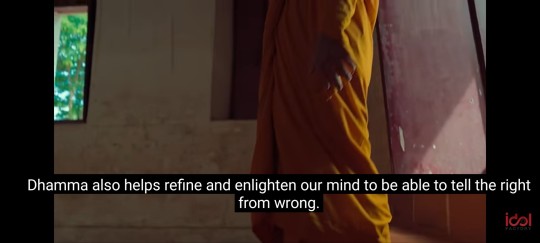
Hearing about Dhamma, my mind immediately went to Dharma, a hindi word often used in tandem with Karma, and a quick google search confirmed that yes, Dhamma is simply the Prakrit (a group of ancient languages) variant of the word Dharma.
It's hard to explain what dharma/dhamma is is english, but I'll do my best. Dhamma is said to mean 'to uphold'. And, in some way, this is true. Dharma revolves around duty, order, and the law of nature. Everyone is born with their own dharma, and must carry it out.
One of the best ways to explain the concept of dharma is the story behind the Bhagvad Gita. I'll do my best to summarize it in a way that is comprehendable to people who've never heard of it.
We begin at the very beginning of a battle, with Arjuna, a great warrior prince. His charioteer is Krishna, an avatar (form on Earth) of the god Vishnu, one of the big 3 gods in Hinduism. Arjuna surveys the battlefield, and sees his uncles and cousins on the opposing side, realizing that he will have to fight against family, and the insurmountable bloodshed that would follow. He fears that waging this war will be adharmic (the opposite of dharma). Arjuna hesitates. He tells Krishna if his worries, who then begins to lecture Arjuna. This lecture is now known as the Bhagvad Gita. Grossly oversimplified, the crux of it is that fighting in this battle is a part of Arjuna's dharma. He is a warrior, and a prince, and this battle is necessary for him and his brothers to regain their kingdom. Fleeing from the battlefield, as Arjuna thought of doing, is what would be considered adharmic.
This is, imo, the best way I can explain the concept of dharma. It heavily emphasizes the concept of the duty that everyone is born with, and must carry out. Obviously, our dharma won't be fighting in a war, but everyone has their own dharma to carry out. Dharma and karma together shape our lives.
I'm hoping we'll learn more about Phaya and Tharn's dharma in future episodes, becauseit would be truly fascinating. Here, the monk (forgive me, I don't remember his name) mentions how dharma helps us distinguish right and wrong; following our duty is right, deviating is wrong. I suspect that Phaya and Tharn deviated from their respective dharmas in their previous lives, Tharn in particular.
Finally, I am by no means an expert on these things. I've offered a rudimentary explanation, but I honestly have no idea how much of this actually makes sense, so I'm tagging @waitmyturtles in case she'd like to add something here. Turtles, I know you're not watching The Sign, but you have been interacting with a few posts about it, so forgive me for asking for a bit of help here.
Side note: Dharma is pronounced as dha-rm, just like Karma is pronounced as ka-rm, NOT kaar-maa. The 'a' makes an 'uh' sound, not aa. Similarly, Dhamma is pronounced as dhamm. And, in The Sign, Karma is said as Kamma, which has essentially the same relationship to Karma as Dhamma does to Dharma.
52 notes
·
View notes
Note
“Amateurs seek the sun. Get eaten.Power stays in the shadows."
Amateurs ; Sam
Power ; caitriona
Dear Oppenheimer Anon (with a European circadian rhythm and no knowledge of the proper use of a semicolon),
If you think your paltry quote from a movie I am in no particular hurry to watch is going to fill me with dread, you are wrong. To that effect, you could have quoted Oppenheimer's Bhagavad Gita's reference (And now I am Death, the destroyer of worlds) during the famous Trinity Test of the atomic bomb, in 1945. But I digress, as usually.
So what is your point, girlfriend? To point out again that S is an amateur, doomed to be eaten alive by your mob, as opposed to consistent, supremely intellectual and feminist icon C?
Fuck me, I am stupid, for refusing to get this Pravda slogan in my head! So since you don't get it, I am going to write it down as clearly as I can. For you and any other twat who thinks she can scare me with movie quotes:
S loves C. C loves S. C and S are parents. I am fascinated by S &C; not particularly by S , C, or any other combo. I am also very glad to be part of a group of witty, funny and kind women who happen to think the same. I am very sorry S upset you all so much by not behaving the way you wanted him to. These people are not your toys and they live their life and their truth as they see fit. Right now, S is in the United States of America promoting his new gin. This is a business side project of his, not a campaign for alcoholism or juvenile prostitution, nor a money extortion operation from gullible fans. This is work. This man is minding his own business: learn a bit from example, Anon? The best places where you could promote a new spirits beverage are clubs, bars, restaurants and specialized retailer venues, with some media coverage added for increased impact. In the meanwhile, C's movie projects are delayed by the Hollywood strike. I am very sorry for her and for them, by the same token, and I wish this situation to be soon over and with as little damage as possible.
But really, I shouldn't have gone to all that trouble, Anon. Your spelling told me everything I needed to know, because you see, Freudian slips are bitches, like that. You used a capital letter to spell only the Amateur's name, while the Power remained minuscule.
That capital letter is the emotional ROI you never got, bitter Anon. Finally, allow me to quote my favorite Christmas movie. Avec le sourire de la crémière:

75 notes
·
View notes
Text
stoicism and the gita got me through a lot as I moved out on my own and had to figure out how to actually survive. I gave them up after I no longer needed them, but I still thought about them a lot. the thing that really bothered me about stoicism in particular, though, was its intense bias against action. maybe epictetus takes this further than others, I don't actually know, but at least to him, the only thing you can control is your own internal state. if you lose your riches, if you lose your freedom, if everyone you love is scoured from the earth, there's nothing you can do to stop it. the only thing you can do is accept it it appealed when I was helpless, but once I felt like I had some control over my life, I grew to despise it. how can you be so weak, to let those things happen to you? I knew he was right, in a sense. senseless things happen, things you can do nothing about. but how can you accept it? you have to fight, you have to win. if you try hard enough, you can defeat reality itself stoicism is cope, but this attitude is cope too. scraping and scrambling for power to make up for the lack of it you once felt. the fear you have that it may still elude you, despite all your efforts. this feeling held immense sway over me much more recently, but I'm more equanimous about these things now he's right, in a sense, that it's all fleeting, and ultimately you need to learn to live with loss. but I do think he makes an error, and his error is treating a continuous thing as if it were discrete you can't control reality with perfect fidelity. but you can influence it. if you believe his essential point that the world is full of things you have power over, and things to which you must acquiesce, there is another answer than to passively accept your lot. it's to go out and find the longest lever you can
5 notes
·
View notes
Text
Another Hinduism/spiritual/philosophy post (based on my current understanding from my readings):
Krishna clearly disavows cults.
He says that the only way to him - for people/devotees to teach his lessons - are for the people who come to him on their own, on their path to moksha (liberation).
We cannot teach anyone who is unwilling to learn, even if they say they are willing - the willingness needs to be ingrained in every, single, part of you, down to your very subconscious.
You must embody it completely and even beyond that. Because to do so is the most powerful act of remembering who you are.
And Krishna purports that through this process, we will realize that this is the only way to break through maya (illusion/delusion).
—
So this is all to say: don’t trust gurus who persuade you via false promises of a happy life, if they are not willing to be honest with you about how you see yourself. I think most gurus are false. I think there are people who provide services that can be helpful, but we must all be careful of who we trust - what is their motivation for helping you?
People do find cults - and I think they’re meant to find them, maybe as a challenge in their own physical-spiritual journey to see that it is yet another mask of delusion. (Oh and Hindus definitely find themselves in cults all the time, lmao)
Much like how many of my past friendships and partnerships were - there were a delusion of what I needed or even wanted.
And as much as I hate to admit it (a weakness of my existence), I haven’t fully let go of many of my maya - I want to, that’s why I study, that’s why I pray, that’s why I seek to achieve enlightenment, that’s why I want to treat people the way I think I should be treated…
I have not mastered many of the elements that Krishna tells Arjun about in the Bhagavad Gita - but it’s not necessarily about mastery, it’s about the process of getting there.
I want to be better - I want to keep learning - I want to keep living.
(I’ve often said this, and I’m not quite sure what he told me, but when I was suicidal in high school, it was ultimately the Bhagavad Gita that saved me.
I picked it up and read it on my own, I stopped listening to my parents’ bullshit, I paused time and meditated on the song and what it was saying, and I came to a conclusion that I cannot remember -
but the spirit of it has always stayed in me, and it is that spirit that propels me to fight to stay strong, to find resources, to find comfort, to feel my emotions, to meltdown, to embrace my body, to worship my goddesses, to find Krishna, to come out as trans, to seek refuge with my friends, to make mistakes, to learn from my mistakes, to be who I am despite of all of life’s challenges.
I strayed away from religion after high school - it shook me to my core because I thought I wouldn’t be a good scientist and because I got caught up in finding love from outside myself -
and now after multiple traumatic life events, I find myself more spiritual and devoted than ever, and I cannot go back. I cannot go back even if I wanted to.)
And because of this want, this compulsion…. which I think is part of the plan anyway, the truth will come to me that it’s always been there.
I think God/Source/the truth is everywhere - it is in every single object/idea we can sense, it is what we experience, it is our inner guiding light, it is within us, it is outside of us, its bigger than us, and it is us. It shows us that no one is better than the other.
I am not perfect nor do I aim to be.
I just want to be me.
—
So this is all further to say that:
We all have it within us to find our own truth, regardless of religion or method.
I will cease to stop telling people who cannot listen (I’ll blog and express myself of course!! People don’t have to listen to me on here, lol!)
Some people need guidance but they will find each other eventually. Connections often tell you what you need to work on.
I hope I continue to find my people/community (and I already have - I’m immensely grateful for my friends from all walks of life).
This is my own truth and journey - it’s something that has brought me immense peace as I continue to navigate this life.
#Hinduism#spiritual growth#healing#neurodivergence#trauma#love#queer#self love#prose#spirituality#Krishna#bhagavad gita#Gita#bhagavadgītā#fuck cults#my journey#healing journey
23 notes
·
View notes
Text
Spring Break Recap - with pictures :)

the day we got off my friends and I went out to town and went to the beach. (so so grateful for where I live)

my (not so baby anymore) cousin visited from Switzerland! we did so many things since this is the first time she had come to Scotland, she is such a bookworm so me and my dad bought her some books from Waterstones. Love her sm :)

Wrote a letter to my school teacher about joining an abroad programme. I really hope I get in as I honestly believe it would be life changing. this was a draft dw! didn't look this scruffy on the final one :P

Cat shelter volunteering (I didn't get any photos of the shelter as I felt that would be inappropriate) this was on the way back though and I thought It looked magical. forever grateful for the scenery around me.

Played around with my new keyboard. It's a Casio and I love it sm, it was gutted by my uncle and auntie from Switzerland. I partially learned Chemtrails Over The Country Club by Lana Del Rey.

My friends birthday party!!! we did pottery painting and I got to paint a highland cow :D got ice cream (yum) and went to the park after.
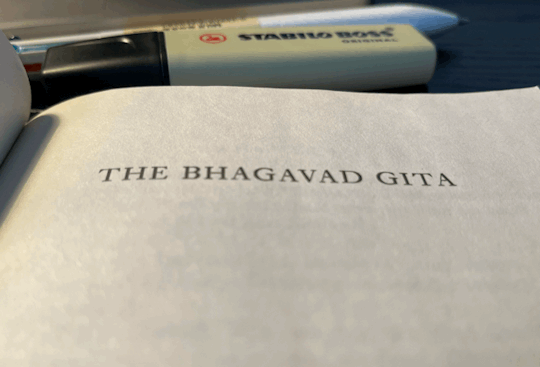
Started reading the Bhagavad Gita. For those who are not aware, the Bhagavad Gita is a Hindu epic scripture that is part of a larger collection of works known as the Mahabharata. The Mahabharata is a Sanskrit epic consisting of over 100,000 shloka (a form of long prose passage) fully forming in to about 1,800,000 (1.8 mil) words and is approximately ten times the length of the Iliad and the Odyssey combined. The length explains why most only read smaller portions such as the Bhagavad Gita which is in fact a poem! ok I could talk about this forever but I hope that someone learned something new from my spiel :P.
Other stuff I did
-Reorganised my note taking and filing system (I could make a whole post about that)
-looked through all my subject specifications to get a feel of how many topics were are (and sub topics... and sub sub topics :,) )
-painted a mini canvas for my friend (dw that wasn't the only thing I got for her birthday)
-did some sketching (my artistic ability comes in waves)
-played Roblox, idc If its childish SUE ME (I am undefeated in paintball 🥱)
-did my extracurriculars (Sangeet and Bengali)
-Celebrated Poyla Boishakh and Vhaisakhi
Goals for new term
-study at least an hour on weekdays
-ace my sangeet exam
-get >6 on everything
-plan for mocks accordingly
-stay consistent
-do assignments as soon as they are given
-have fun
..............................................................................................................................
Ok this was long but I feel as if I did my break justice, a lot went on and it would be wrong to not give details.
thank you so much for reading this long post
Signing off~
StingrayStudies
#student#studyspo#study motivation#study#studying#studylapse#studyinspo#studyblr#bhagavad gita#hinduism#hindi#desi studyblr#desi teen#desiblr#desi tag#desi tumblr#study aesthetic#study blog
13 notes
·
View notes
Text

Jesus the Avatar
God’s Manifestation in Divine Incarnations
For mere mortals to cope with a life of unsolved and unsolvable mysteries in an inscrutable universe would indeed be an overwhelming challenge were it not for divine emissaries who come on earth to speak with the voice and authority of God for the guidance of man. Aeons past, in ancient higher ages in India, rishis enunciated the manifestation of Divine Beneficence, of “God with us,” in terms of divine incarnations, avatars—God incarnate on earth in enlightened beings…. Many are the voices that have intermediated between God and man, khanda avatars, or partial incarnations in God-knowing souls. Less common are the purna avatars, liberated beings who are fully one with God; their return to earth is to fulfill a God-ordained mission. The Lord in the sacred Hindu Bible, the Bhagavad Gita, declares:
“Whenever virtue declines and vice predominates, I incarnate as an Avatar. In visible form I appear from age to age to protect the virtuous and to destroy evildoing in order to reestablish righteousness.”
The same one glorious infinite consciousness of God, the Universal Christ Consciousness, Kutastha Chaitanya, becomes familiarly apparelled in the individuality of an enlightened soul, graced with a distinguishing personality and godly nature appropriate to the times and purpose of thet incarnation. Without this intercession of God’s love come to earth in the example, message, and guiding hand of His avatars, it would scarce be possible for groping humanity to find the path into God’s kingdom midst the dark miasma of world delusion, the cosmic substance of human habitation. Lest His benighted children be lost forever in creation’s delusive labyrinths, the Lord comes again and again in God-illumined prophets to light the way….
Jesus was preceded by Gautama Buddha, the “Enlightened One,” whose incarnation reminded a forgetful generation of the Dharma Chakra, the ever-rotating wheel of karma—self-initiated action and its effects which make each man, and not a Cosmic Dictator, responsible for his own present condition. Buddha brought heart back into the arid theology and mechanical rituals into which the ancient Vedic religion of India had fallen after the passing of a higher age in which Bhagavan Krishna, India’s most beloved of avatars, preached the way of divine love and God-realization through the practice of the supreme spiritual science of yoga, union with God.
Divine intercession to mitigate the cosmic law of cause and effect [karma], by which a man suffers from his errors, was at the heart of the mission of love Jesus came to fulfill…. Jesus came to demonstrate the forgiveness and compassion of God, whose love is a shelter even from exacting law. The Good Shepherd of souls opened his arms to all, rejecting none, and with universal love coaxed the world to follow him on the path to liberation through the example of his spirit of sacrifice, renunciation, forgiveness, love for friend and enemy alike, and supreme love for God above all else. As the tiny babe in the manger at Bethlehem, and as the savior who healed the sick and raised the dead and applied the salve of love on the wounds of errors, the Christ in Jesus lived among men as one of them that they too might learn to live like gods.
Christ Consciousness: Oneness With God’s Infinite Intelligence and Bliss Pervading All Creation
To understand the magnitude of a divine incarnation, it is necessary to understand the source and nature of the consciousness that is incarnate in the avatar. Jesus spoke of this consciousness when he proclaimed: “I and my Father are one” (John 10:30) and “I am in the Father, and the Father in me” (John 14:11). Those who unite their consciousness to God know both the transcendent and the immanent nature of Spirit—the singularity of the ever-existing, ever-conscious, ever-new Bliss of the Uncreate Absolute, and the myriad manifestations of His Being as the infinitude of forms into which He variegates Himself in the panorama of creation.
There is a distinguishing difference of meaning between Jesus and Christ. His given name was Jesus; his honorific title was “Christ.” In his little human body called Jesus was born the vast Christ Consciousness, the omniscient Intelligence of God omnipresent in every part and particle of creation.
The universe is not the result merely of a fortuitous combination of vibrating forces and subatomic particles, as proposed by material scientists —a chance excrescence of solids, liquids, and gases into earth, oceans, atmosphere, plants, all harmoniously interrelated to provide a habitable home for human beings. Blind forces cannot organize themselves into intelligently structured objects. As human intelligence is needed to put water into the small square compartments of an ice tray to be frozen into cubes, so in the coalescence of vibration into progressively evolving forms throughout the universe we see the results of a hidden Immanent Intelligence.
What could be more miraculous than the evident presence in every speck of creation of a Divine Intelligence? How the mighty tree emerges from a tiny seed. How countless worlds roll in infinite space, held in a purposeful cosmic dance by the precise adjustment of universal forces. How the marvelously complex human body is created from a single microscopic cell, is endowed with self-conscious intelligence, and is sustained, healed, and enlivened by invisible power. In every atom of this astounding universe, God is ceaselessly working miracles; yet obtuse man takes them for granted.
Christ is God’s Infinite Intelligence that is present in all creation. The Infinite Christ is the “only begotten son” of God the Father, the only pure Reflection of Spirit in the created realm. That Universal Intelligence, the Kutastha Chaitanya or Krishna Consciousness of the Hindu scriptures, was fully manifested in the incarnation of Jesus, Krishna, and other divine ones; and it can be manifested also in your consciousness.
― Paramahansa Yogananda, The Yoga of Jesus: Understanding the Hidden Teachings of the Gospels
#Paramahansa Yogananda#The Yoga of Jesus: Understanding the Hidden Teachings of the Gospels#Christ Consciousness#Kutastha Chaitanya#Jesus the Avatar
3 notes
·
View notes
Photo
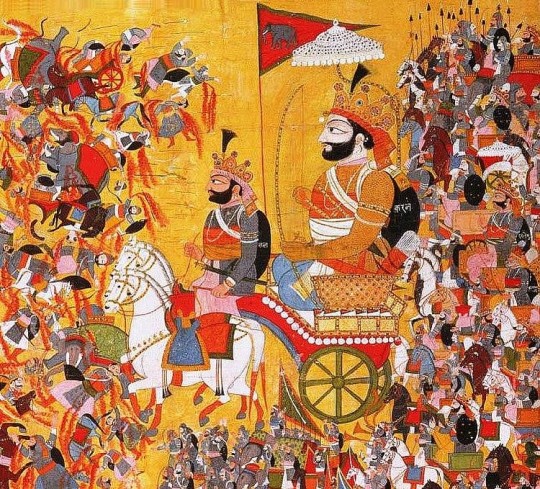
Mahabharata
The Mahabharata is an ancient Indian epic where the main story revolves around two branches of a family - the Pandavas and Kauravas - who, in the Kurukshetra War, battle for the throne of Hastinapura. Interwoven into this narrative are several smaller stories about people dead or living, and philosophical discourses. Krishna-Dwaipayan Vyasa, himself a character in the epic, composed it; as, according to tradition, he dictated the verses and Ganesha wrote them down. At 100,000 verses, it is the longest epic poem ever written, generally thought to have been composed in the 4th century BCE or earlier. The events in the epic play out in the Indian subcontinent and surrounding areas. It was first narrated by a student of Vyasa at a snake-sacrifice of the great-grandson of one of the major characters of the story. Including within it the Bhagavad Gita, the Mahabharata is one of the most important texts of ancient Indian, indeed world, literature.
Learn more about Mahabharata
100 notes
·
View notes
Text
Transformational Benefits of Yoga Teacher Training Beyond the Mat
Yoga teacher training (YTT) is more than a journey toward becoming a certified yoga instructor; it is a profound transformative experience that transcends the mat. At institutions like Om Shanti Om Yoga Ashram in Rishikesh, participants immerse themselves in an environment that fosters personal growth, self-discovery, and a deeper understanding of yoga’s holistic philosophy. Here’s how YTT impacts various dimensions of life:

1. Deepening Self-Awareness and Personal Growth
Yoga teacher training provides a structured environment for introspection. Through daily meditation, mindfulness practices, and philosophical discussions, participants gain clarity about their inner selves. The teachings encourage letting go of limiting beliefs, fostering resilience, and embracing authenticity.
2. Enhanced Emotional Intelligence
By exploring yogic philosophy and the art of mindfulness, trainees learn to regulate emotions better. This emotional intelligence improves personal relationships, encourages empathy, and nurtures a sense of inner calm, even in challenging situations.
3. Building a Stronger Connection to Others
The communal living experience during YTT often forges lifelong friendships. Shared growth and learning experiences cultivate compassion, understanding, and a sense of belonging. These connections extend into a broader yoga community that offers ongoing support and collaboration.
4. Cultivating a Balanced Lifestyle
Training introduces holistic living concepts, integrating practices like balanced nutrition, proper sleep, and stress management. These principles become lifelong habits that enhance well-being and vitality.
5. Spiritual Awakening
Yoga teacher training emphasizes spiritual growth through practices like meditation, chanting, and studying ancient texts like the Bhagavad Gita. This spiritual awakening often leads to a greater sense of purpose and connection with the universe.
6. Skill Development and New Opportunities
Beyond mastering advanced asanas, trainees acquire valuable teaching skills such as class planning, communication, and adaptability. These skills are applicable in yoga studios and beneficial in any professional or personal setting.
7. Becoming a Change Agent

At Om Shanti Om Yoga Ashram, this transformative journey is amplified by the serene Himalayan setting and a curriculum steeped in authenticity and tradition. Guided by experienced yogis, participants leave with more than a certification — they gain tools for lifelong empowerment and well-being.
For more details about yoga teacher training at Om Shanti Om, you can visit their official website.
#yoga#yoga teacher#yoga teacher training#yoga philosophy#hatha yoga#yoga ttc in rishikesh#yoga studio#yoga class#yoga center#yoga retreats
2 notes
·
View notes
Text

#जाति_मनुष्यकी_अशांति_का_कारण
एकता ही समाज की शांति का रास्ता है। हम सभी एक ही परमात्मा की संतान हैं।
♦️Learn this secret from the amazing book "Gita Tera Gyan Amrit" written by Saint Rampal Ji Maharaj.
Living Being Is Our Race
2 notes
·
View notes
Text
Which deity is more popular in North India, Lord Ram or Lord Krishna?
Imagine walking through the lively streets of North India, where every corner holds a new tale, a fresh festivity, and a deity waiting to be honored. Now, let's dive into the enchanting world of Lord Ram and Lord Krishna, two beloved figures who weave their magic through the hearts of the people.
In Uttar Pradesh, where Ayodhya proudly proclaims itself as Ram's birthplace, there's a palpable sense of devotion that fills the air, especially during Ram Navami and the dazzling Diwali festival. It's as if the entire town bursts into life, painting the streets with vibrant colors and echoing chants, all celebrating Ram's virtues of righteousness and duty.
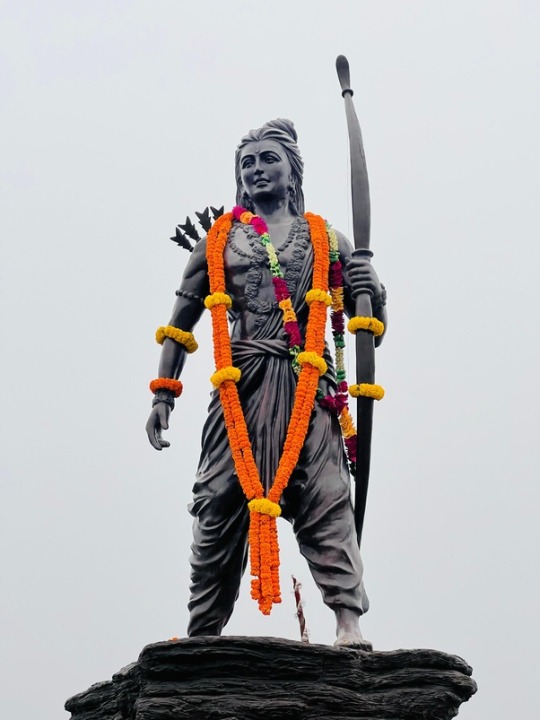
But take a stroll into the cozy lanes of Vrindavan and Mathura, and you'll find a different kind of enchantment. Here, it's all about Krishna – the charming trickster whose flute melodies and playful antics stole the hearts of all who encountered him. During Janmashtami, the celebration of his birth, these towns transform into whirlwinds of joy and festivity, as if Krishna's laughter still dances through the air.
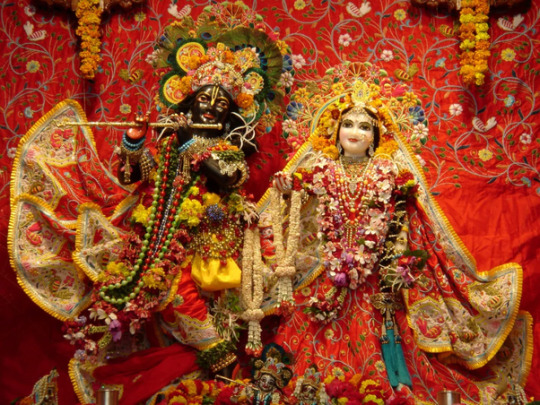
What's truly captivating is how deeply people connect with these divine beings. For some, it's Ram's unwavering strength and moral compass that resonate in their souls, guiding them through life's challenges. For others, it's Krishna's playful wisdom, especially as the charioteer in the Bhagavad Gita, that offers comfort and guidance in times of uncertainty. It's like choosing a beloved character from a cherished story – each one speaks to us in a unique way, touching our hearts and shaping our beliefs.
Ultimately, it's not about who's more popular or who receives the most offerings. It's about forging a personal connection with the divine, finding solace and inspiration in their stories and teachings. Whether we're drawn to Ram's sense of duty or Krishna's playful charm, Hinduism offers a rich tapestry of beliefs that invites us to explore, connect, and find our own path to the divine, guided by the warmth of human emotion and connection."
Certainly! Both Lord Ram and Lord Krishna offer profound teachings that continue to inspire millions of people worldwide.
Learnings from Lord Ram:
Duty and Responsibility: Ram epitomizes the principle of duty and responsibility. His unwavering commitment to upholding dharma (righteousness) and fulfilling his responsibilities as a son, husband, and king teaches us the importance of fulfilling our duties with dedication and integrity.
Resilience in Adversity: Ram's life is marked by numerous challenges and trials, including exile from his kingdom and the abduction of his wife, Sita. Yet, he faces each adversity with courage, resilience, and grace, teaching us the value of perseverance and steadfastness in the face of hardship.
Compassion and Forgiveness: Despite the injustices he faces, Ram embodies compassion and forgiveness. His willingness to forgive even those who wronged him, such as Ravana, demonstrates the power of compassion and the importance of letting go of resentment.
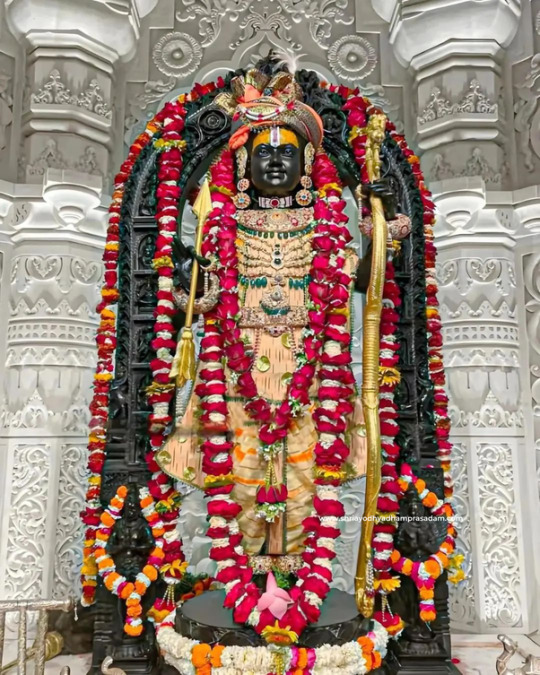
Learnings from Lord Krishna:
Wisdom and Guidance: Krishna, often revered as the divine teacher, imparts profound wisdom and guidance to Arjuna in the Bhagavad Gita. His teachings on duty, righteousness, and the nature of existence provide invaluable insights into navigating life's complexities with wisdom and clarity.
Detachment and Surrender: Krishna emphasizes the importance of detachment from the fruits of our actions and surrendering to the divine will. By relinquishing attachment to outcomes and surrendering to the greater cosmic plan, we can find inner peace and liberation from suffering.
Devotion and Love: Krishna's divine love and devotion, particularly in his interactions with his devotees like Radha, exemplify the power of unconditional love and devotion in forging a deep connection with the divine. His teachings remind us of the transformative power of love in transcending worldly boundaries and experiencing spiritual union.
In essence, the teachings of Lord Ram and Lord Krishna offer timeless wisdom and guidance for navigating life's journey with integrity, resilience, compassion, and spiritual insight.
"Explore Ayodhya and Sanatan Dharma's essence with us! Visit our website http://www.shriayodhyadhamprasadam.com to dive into their timeless wisdom and offerings.
Let’s sustain and spread essence of our dharma together. Join the journey now!"
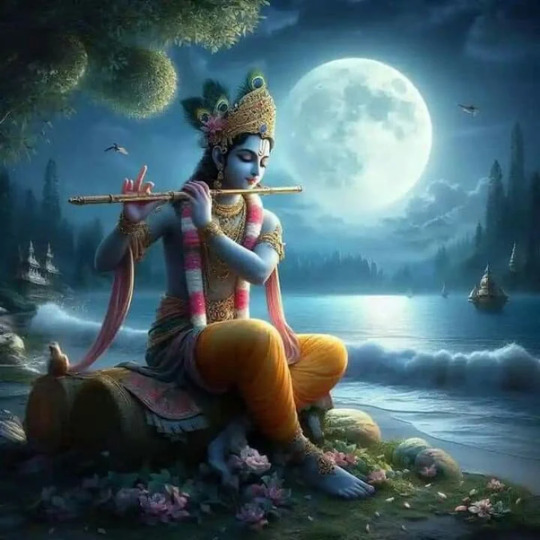
#ayodhya#ram mandir#jai shree ram#bharat#inspirational quotes#ramayana#ayodharammandir#vrindavan#hare krishna#uttarpradesh#branding#north india tour#india#sanatandharma#sanatani#hinduism
5 notes
·
View notes
Text


Jai Shree Krishna
Hare Krishna (mantra):
Hare Rama Hare Rama
Rama Rama Hare Hare
Hare Krishna Hare Krishna
Krishna Krishna Hare Hare
- Kali-Santarana Upanisad
Just try to learn the truth by approaching a spiritual master. Inquire from him submissively and render service unto him. The self-realized souls can impart knowledge unto you because they have seen the truth.
Having obtained real knowledge from a self-realized soul, you will never fall again into such illusion, for by this knowledge you will see that all living beings are but part of the Supreme, or, in other words, that they are Mine.
Even if you are considered to be the most sinful of all sinners, when you are situated in the boat of transcendental knowledge you will be able to cross over the ocean of miseries.
As a blazing fire turns firewood to ashes, O Arjuna, so does the fire of knowledge burn to ashes all reactions to material activities.
In this world, there is nothing so sublime and pure as transcendental knowledge. Such knowledge is the mature fruit of all mysticism. And one who has become accomplished in the practice of devotional service enjoys this knowledge within himself in due course of time.
A faithful man who is dedicated to transcendental knowledge and who subdues his senses is eligible to achieve such knowledge, and having achieved it he quickly attains the supreme spiritual peace.
But ignorant and faithless persons who doubt the revealed scriptures do not attain God consciousness; they fall down. For the doubting soul there is happiness neither in this world nor in the next.
—Bhagavad-gita, 4.34-40
9 notes
·
View notes
Text
Early in the morning of July 16, 1945, before the sun had risen over the northern edge of New Mexico’s Jornada Del Muerto desert, a new light—blindingly bright, hellacious, blasting a seam in the fabric of the known physical universe—appeared. The Trinity nuclear test, overseen by theoretical physicist J. Robert Oppenheimer, had filled the predawn sky with fire, announcing the viability of the first proper nuclear weapon and the inauguration of the Atomic Era. According to Frank Oppenheimer, brother of the “Father of the Bomb,” Robert’s response to the test’s success was plain, even a bit curt: “I guess it worked.”
With time, a legend befitting the near-mythic occasion grew. Oppenheimer himself would later attest that the explosion brought to mind a verse from the Bhagavad Gita, the ancient Hindu scripture: “If the radiance of a thousand suns were to burst at once into the sky, that would be like the splendor of the mighty one.” Later, toward the end of his life, Oppenheimer plucked another passage from the Gita: “Now I am become Death, the destroyer of worlds.”
Christopher Nolan’s epic, blockbuster biopic Oppenheimer prints the legend. As Oppenheimer (Cillian Murphy) gazes out over a black sky set aflame, he hears his own voice in his head: “Now I am become Death, the destroyer of worlds.” The line also appears earlier in the film, as a younger “Oppie” woos the sultry communist moll Jean Tatlock (Florence Pugh). She pulls a copy of the Bhagavad Gita from her lover’s bookshelf. He tells her he’s been learning how to read Sanskrit. She challenges him to translate a random passage on the spot. Sure enough: “Now I am become Death, the destroyer of worlds.” (That the line comes in a postcoital revery—a state of bliss the French call la petite mort, “the little death”—and amid a longer conversation about the new science of Freudian psychoanalysis—is about as close to a joke as Oppenheimer gets.)
As framed by Nolan, who also wrote the screenplay, Oppenheimer's cursory knowledge of Sanskrit, and Hindu religious tradition, is little more than another of his many eccentricities. After all, this is a guy who took the “Trinity” name from a John Donne poem; who brags about reading all three volumes of Marx’s Das Kapital (in the original German, natch); and, according to Kai Bird and Martin J. Sherwin’s biography, American Prometheus, once taught himself Dutch to impress a girl. But Oppenheimer’s interest in Sanskrit, and the Gita, was more than just another idle hobby or party trick.
In American Prometheus, credited as the basis for Oppenheimer, Bird and Sherwin depict Oppenheimer as more seriously committed to this ancient text and the moral universe it conjures. They develop a resonant image, largely ignored in Nolan’s film. Yes, it’s got the quote. But little of the meaning behind it—a meaning that illuminates Oppenheimer’s own conception of the universe, of his place in it, and of his ethics, such as they were.
Composed sometime in the first millennium, the Bhagavad Gita (or “Song of God”) takes the form of a poetic dialog between a warrior-prince named Arjuna and his charioteer, the Hindu deity Krishna, in unassuming human form. On the cusp of a momentous battle, Arjuna refuses to engage in combat, renouncing the thought of “slaughtering my kin in war.” Throughout their lengthy back-and-forth (unfolding over some 700 stanzas), Krishna attempts to ease the prince’s moral dilemma by attuning him to the grander design of the universe, in which all living creatures are compelled to obey dharma, roughly translated as “virtue.” As a warrior, in a war, Krishna maintains that it is Arjuna’s dharma to serve, and fight; just as it is the sun’s dharma to shine and water’s dharma to slake the thirsty.
In the poem’s ostensible climax, Krishna reveals himself as Vishnu, Hinduism’s many-armed (and many-eyed and many-mouthed) supreme divinity; fearsome and magnificent, a “god of gods.” Arjuna, in an instant, comprehends the true nature of Vishnu and of the universe. It is a vast infinity, without beginning and end, in a constant process of destruction and rebirth. In such a mind-boggling, many-faced universe (a “multiverse,” in the contemporary blockbuster parlance), the ethics of an individual hardly matter, as this grand design repeats in accordance with its own cosmic dharma. Humbled and convinced, Arjuna takes up his bow. As recounted in American Prometheus, the story had a significant impact on Oppenheimer. He called it “the most beautiful philosophical song existing in any known tongue.” He praised his Sanskrit teacher for renewing his “feeling for the place of ethics.” He even christened his Chrysler Garuda, after the Hindu bird-deity who carries the Lord Vishnu. (That Oppenheimer seems to identify not with the morally conflicted Arjuna but with the Lord Vishnu himself may say something about his own sense of self-importance.)
“The Gita,” Bird and Sherwin write, “seemed to provide precisely the right philosophy.” Its prizing of dharma, and duty as a form of virtue, gave Oppenheimer’s anguished mind a form of calm. With its notion of both creation and destruction as divine acts, the Gita offered Oppenheimer a frame of making sense of (and, later, justifying) his own actions. It’s a key motivation in the life of a great scientist and theoretician, whose work was marshaled toward death. And it’s precisely the sort of idea Nolan rarely lets seep into his movies.
Nolan’s films—from the thriller Memento and his Batman trilogy to the sci-fi opera Interstellar and the time-reversal blockbuster Tenet—are ordered around puzzles and problem-solving. He establishes a dilemma, provides the “rules,” and then sets about solving that dilemma. For all his sci-fi high-mindedness, he allows very little room for questions of faith or belief. Nolan's cosmos is more like a complicated puzzle box. He has popularized a kind of sapio-cinema, which makes a virtue of intelligence without being itself highly intellectual.
At their best, his movies are genuinely clever in conceit and construct. The one-upping stage magicians of The Prestige, who go mad trying to best one another, are distinctly Nolanish figures. The tripartite structure of Dunkirk—which weaves together plot lines that unfold across distinct periods of time—is likewise inspired. At their worst, Nolan’s films collapse into ponderousness and pretension. The barely scrutable reality-distortion mechanics of Inception, Interstellar, and Tenet smack of hooey.
Oppenheimer seems similarly obsessed with problem-solving. First, Nolan sets up some challenges for himself. Such as: how to depict a subatomic fission reaction at Imax scale or, for that matter, how to make a biopic about a theoretical physicist as a broadly entertaining summer blockbuster. Then he sets to work. To his credit, Oppenheimer unfolds breathlessly and succeeds making dusty-seeming classroom conversations and chatty closed-door depositions play like the stuff of a taut, crowd-pleasing thriller. The cinematography, at both a subatomic and megaton scale, is also genuinely impressive. But Nolan misses the deeper metaphysics undergirding the drama.
The movie depicts Murphy’s Oppenheimer more as a methodical scientist. Oppenheimer, the man, was a deep and radical thinker whose mind was grounded by the mystical, the metaphysical, and the esoteric. A film like Terrence Malick’s Tree of Life shows that it is possible to depict these sort of higher-minded ideas at the grand, blockbuster scale, but it’s almost as if they don’t even occur to Nolan. One might, charitably, claim that his film’s time-jumping structure reflects the Gita’s notion of time itself as nonlinear. But Nolan’s reshuffling of the story’s chronology seems more born of a showman’s instinct to save his big bang for a climax. When the bomb does go off, and its torrents of fire fill the gigantic Imax screen, there’s no sense that the Lord Vishnu, the mighty one, is being revealed in that “radiance of a thousand suns.” It’s just a big explosion. Nolan is ultimately a journeyman technician, and he maps that personality onto Oppenheimer. Reacting to the horrific, militarily unjustifiable bombings of Nagasaki and Hiroshima (which are never depicted on-screen), Murphy’s Oppenheimer calls them “technically successful.”
Judged against the life of its subject, Oppenheimer can feel like a bit of let down. It fails to comprehend the woolier, yet more substantial, worldview that animated Oppie’s life, work, and own moral torment. Weighed against Nolan’s own, more purely practical, ambitions, perhaps the best that can be said of Oppenheimer is that—to paraphrase the physicist’s actual reported comments, uttered at his moment of ascension to the status of godlike world-destroyer—it works. Successful, if only technically.
18 notes
·
View notes